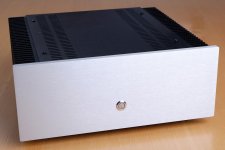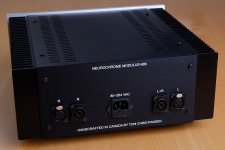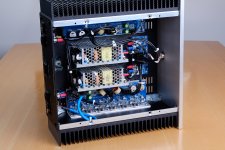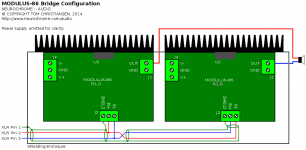It is clear that all of the amps in question will provide more than enough wattage for my system. One thing to note is that the 686 is a balanced architecture from input to output while the others are balanced through the input only. This could give the 686 some advantage but at this point I doubt it would be enough to justify the extra cost. Although, I would definitely do it if I was spending some else's money The 186 looks to be the best choice unless someone who has the 186 or 286 AND the 686 can expound on audible improvement from the 686. Maybe I should build all of them and sell what I don't want/need! That might be the only way to know for sure.
The 186 looks to be the best choice unless someone who has the 186 or 286 AND the 686 can expound on audible improvement from the 686. Maybe I should build all of them and sell what I don't want/need! That might be the only way to know for sure.
Chris,
The input circuitry for all the Modulus series of amps are differential/balanced as you have discerned. This is the area where I believe that differential circuitry is best used. That being said, one can go further.
The Modulus 86 uses the THAT1200 IC while the 186, 286, and 686 do not, they are nearly 100% SMD and use some of the most tricked out IC’s out there. Tom’s website gives you the details. The 186, 286 and 686 are all better sounding even at the 1 watt level than the Modulus 86. It isn’t night and day exactly but the differences particularly with the 686 come with more intrinsic detail, blacker soundstaging, more imaging precision and an “ease” to the music. They are all very neutral. This isn’t the amplifier series that is about “entertainment “, tweaking or colorations. If the 686 was used in every studio in the recording industry we would all benefit from it.
People really don’t realize HOW MUCH power they need especially if their speakers are free from SPL compression at higher SPL levels. Most 82-88 dB speakers begin to compress at 80+ dB and then are seriously compressed in the mid 90’s and above. I realize that’s loud for some folks, but that’s only because you are listening to a speaker design that can’t play that loud in the 1st place.
The measurements show that the 686 has the best SNR and best dynamic range to boot. If you were to ask me which amp has the best performance at 1-5 watts, it’s the 686 period. The 286 is no slouch until you hear the 686 and if you decide to crank up the volume, the 686 takes over. I bet the 686 would be operating in Class A most of the time with 100+ dB sensitive speakers. That’s great if you want to afford it.
I get my hearing checked every year by the same audiologist. I have my back facing him and he plays various test tones. Basically my threshold of hearing from 100Hz to 8khz for each ear is about 15dB. That’s as good as a 5 year old and I am in my mid 40’s. He also has another device which isn’t approved by the American Audiology Association and he says I can still hear at least to 12khz, again at a threshold of 15dB.
Tom’s designs (if we are only talking about Class AB) are a bargain for what you get. A fully built board and excellent instructions and fantastic email support . The boards are gorgeously built and fully tested. The biggest problem with Tom’s 686 is that it killed the diy amp building hobby in me because listening sessions last for 6 hours or more. That means my butt isn’t in the lab working on yet another amp build which I enjoy. I am sure there is more secret sauce in the 686 that isn’t revealed for obvious reasons!
That’s a good thing if you just want one great amp and be done with it!
I realize I am not much of any help to the OP! You can always upgrade though! Enjoy.
Best,
Anand.
The input circuitry for all the Modulus series of amps are differential/balanced as you have discerned. This is the area where I believe that differential circuitry is best used. That being said, one can go further.
The Modulus 86 uses the THAT1200 IC while the 186, 286, and 686 do not, they are nearly 100% SMD and use some of the most tricked out IC’s out there. Tom’s website gives you the details. The 186, 286 and 686 are all better sounding even at the 1 watt level than the Modulus 86. It isn’t night and day exactly but the differences particularly with the 686 come with more intrinsic detail, blacker soundstaging, more imaging precision and an “ease” to the music. They are all very neutral. This isn’t the amplifier series that is about “entertainment “, tweaking or colorations. If the 686 was used in every studio in the recording industry we would all benefit from it.
People really don’t realize HOW MUCH power they need especially if their speakers are free from SPL compression at higher SPL levels. Most 82-88 dB speakers begin to compress at 80+ dB and then are seriously compressed in the mid 90’s and above. I realize that’s loud for some folks, but that’s only because you are listening to a speaker design that can’t play that loud in the 1st place.
The measurements show that the 686 has the best SNR and best dynamic range to boot. If you were to ask me which amp has the best performance at 1-5 watts, it’s the 686 period. The 286 is no slouch until you hear the 686 and if you decide to crank up the volume, the 686 takes over. I bet the 686 would be operating in Class A most of the time with 100+ dB sensitive speakers. That’s great if you want to afford it.
I get my hearing checked every year by the same audiologist. I have my back facing him and he plays various test tones. Basically my threshold of hearing from 100Hz to 8khz for each ear is about 15dB. That’s as good as a 5 year old and I am in my mid 40’s. He also has another device which isn’t approved by the American Audiology Association and he says I can still hear at least to 12khz, again at a threshold of 15dB.
Tom’s designs (if we are only talking about Class AB) are a bargain for what you get. A fully built board and excellent instructions and fantastic email support . The boards are gorgeously built and fully tested. The biggest problem with Tom’s 686 is that it killed the diy amp building hobby in me because listening sessions last for 6 hours or more. That means my butt isn’t in the lab working on yet another amp build which I enjoy. I am sure there is more secret sauce in the 686 that isn’t revealed for obvious reasons!
That’s a good thing if you just want one great amp and be done with it!
I realize I am not much of any help to the OP! You can always upgrade though! Enjoy.
Best,
Anand.
Note that 'SNR' is not necessarily the best way to compare noise. SNR is often measured relative to rated output power, so two amps with the same output noise will have different SNRs, the higher-power amp being 'better'. Given the case being discussed, high speaker sensitivity, you want to look at the output noise spec that Tom gives. Sometimes amp specs will include S/N relative to 1W, in which case you can compare specs directly.
Note that 'SNR' is not necessarily the best way to compare noise. SNR is often measured relative to rated output power, so two amps with the same output noise will have different SNRs, the higher-power amp being 'better'. Given the case being discussed, high speaker sensitivity, you want to look at the output noise spec that Tom gives. Sometimes amp specs will include S/N relative to 1W, in which case you can compare specs directly.
Correct. When you compare output noise spec of the Modulus 686, particularly at the 20dB gain setting, 16uV rms is amazing!
Best,
Anand.
Tom brought a 686 in a 3U Mini 300 case as I remember to BA2018? He had to so it could fit in his suitcase. That’s the most compact I’ve seen for that amp. It was lower output as well.
https://www.diyaudio.com/forums/ven...wer-amp-extremely-low-thd-61.html#post5511006
Best,
Anand.
https://www.diyaudio.com/forums/ven...wer-amp-extremely-low-thd-61.html#post5511006
Best,
Anand.
I'm interested in trying a Neurochrome amp to pair with 101db horns (Wayne Parham's 7pi)
To add further to the echo: You really don't need much power for that. I would recommend the Modulus-186.
If your drivers are 8 Ω or higher, you can optimize your build for that by using a power supply voltage of ±35-36 V. That gives you 60 W into 8 Ω. That's enough for 118 dB SPL with a 101 dB efficient driver. So at least 121 dB SPL with two drivers and louder with room gain. Basically you'll blow your hearing (literally!!) before the amp runs out of power.
The main difference, technically, between the Modulus-86 and -186 is that the Modulus-86 uses a THAT1200 for the balanced input which limits its noise performance. The Modulus-186 and above have lower noise as result. I think you'll enjoy that with 101 dB efficient drivers.
The Modulus-86 is all-DIY. You buy the blank boards from me and assemble it yourself. The Modulus-186 and above are all fully assembled modules.
All the Modulus amps employ the same overall concept: Error-correction. They use a precision opamp (and in case of the MOD686 a precision differential amp) to perform error correction on an LM3886 (or multiple of them in parallel or bridge/parallel).
The Modulus-186 and -286 share the same architecture. The -286 "just" uses two LM3886es in parallel for higher output current whereas the -186 has only one LM3886. The Modulus-686 is a bridged/parallel amp with differential feedback. Same concept, but different architecture.
Can anyone help me with sonic differences between 186, 286 and 686 amps?
I think Anand described that well above.
I'm looking smooth, transparent, effortless sound and I want to get the most out of the build in terms of sound quality without overspending on unused power.
Then I stand by my recommendation of the Modulus-186.
Tom
Tom brought a 686 in a 3U Mini 300 case as I remember to BA2018? He had to so it could fit in his suitcase.
Heh. Yeah. That was a fun build. I managed to fit two of them in my suitcase and still squeeze in under the 21 kg weight limit.
I call that build the Safe-n-Sane build. It runs on ±27 V from a pair of Mean Well RPS-400-27-C and provides 130 W into 8 Ω and 200 W into 4 Ω. The lower supply voltage means lower power dissipation, which allows for a smaller heat sink (3U x 300 mm) to be used. I really like the small "power cube" form factor. You can read more about it here: Choosing Your Amp – Neurochrome
The chassis is a ModuShop Mini Dissipante 3U x 300 x 330 mm.
That build used the Mean Well Controller and Rev. 1.0 of the Modulus-686. I will soon discontinue the Mean Well Controller as the Intelligent Soft Start can do the same job better. The Modulus-686 is now in Rev. 1.1 and has a slightly different drill pattern, so the old CAD drawings are obsolete (or I'd put them on my website).
For future builds, I would likely use the cage-free version of the RPS-400 and mount the supplies either stacked or on an L-bracket. It turns out that mounting the supplies by their cages (even with Mean Well's blessing) wasn't such a hot idea as the supplies tend to wiggle in transit. In some cases the wiggle was enough to bend the cage on the power supply. As result I shipped the four I built with an internal foam brace that the buyer then removed when they took delivery of the amp. That's fine for DIY but isn't the unboxing experience I aim for.
Once I have the CAD drawings for the updated Safe-n-Sane Build available I'll put them in the Resources tab on the Modulus-686 product page.
Tom
Attachments
Last edited:
Did you perhaps mean the other way around re the LX minis; i.e. 186 for the tweeters and 286 for the mid-woofers?
If you enjoy listening to loud music with the LXmini, you will likely want a little more power than the 4 x Modulus-86 amp can provide. In that case, an amp with two channels of Modulus-86 (or Modulus-186) for the woofers and two channels of Modulus-286 for the tweeters would work well for you. I recommend powering it by a Power-86 (or Power-686) and a 2x25 VAC, 300-400 VA power transformer.
Did you perhaps mean the other way around re the LX minis; i.e. 186 for the tweeters and 286 for the mid-woofers?
Nope. LXmini drivers:
- Woofer: SEAS Prestige L16RN-SL (8 Ω)
- Tweeter: SEAS Prestige FU10RB (4 Ω)
...and Modulus-286 on each of the SEAS L26RO4Y (4 Ω) subwoofers if you're going for the LXstudio.
You can find a more detailed explanation here: Taming the LM3886 Chip Amplifier: Output Power – Neurochrome
Keep in mind that the Modulus-186 uses one LM3886 and the Modulus-286 uses two LM3886 in parallel.
Tom
Last edited:
OK, so two things:
- that much math hertz ma brain;
- have you yet published a schema or block diagram for how the following might be accomplished?
I assume that the total PS and heat dissipation requirements for such a project would be less than for a 686, whether implemented as monoblocks or stereo?
- that much math hertz ma brain;
- have you yet published a schema or block diagram for how the following might be accomplished?
If the Modulus-86 does not provide enough power for you, the best option in the current Modulus line-up is the Modulus-286. When operated on ±35 V supply rails it provides 60 W (8 Ω), 100 W (4 Ω). Two Modulus-286 modules may be bridged and operated on a ±28 V supply for 150 W (8 Ω), 270 W (4 Ω) of output power.
I assume that the total PS and heat dissipation requirements for such a project would be less than for a 686, whether implemented as monoblocks or stereo?
I haven't sketched one specifically for the MOD286, but here's one I drew up many moons ago for the Modulus-86.
Now before everybody gets all excited about bridging their Modulus-86 amps, keep in mind that with its 7 A output current it's really not a good candidate for bridging unless you want to drive a 16 Ω load.
The Modulus-286 (on ±28-30 V) would be able to drive a 4 Ω load bridged. 150 W, 270 W sound optimistic, though. I would expect the same or slightly lower output power than the Modulus-686 Safe-n-Sane build. So probably more like 130 W, 200 W for 8, 4 Ω, respectively.
The power dissipation would be the same as for the Modulus-686 Safe-n-Sane build, so you'd still need a 3U x 300 mm deep chassis.
Tom
Now before everybody gets all excited about bridging their Modulus-86 amps, keep in mind that with its 7 A output current it's really not a good candidate for bridging unless you want to drive a 16 Ω load.
The Modulus-286 (on ±28-30 V) would be able to drive a 4 Ω load bridged. 150 W, 270 W sound optimistic, though. I would expect the same or slightly lower output power than the Modulus-686 Safe-n-Sane build. So probably more like 130 W, 200 W for 8, 4 Ω, respectively.
The power dissipation would be the same as for the Modulus-686 Safe-n-Sane build, so you'd still need a 3U x 300 mm deep chassis.
Tom
Attachments
Thanks.
Edit; of course you and others would no doubt point out that with only a $110 difference in price between the modules, and the fact that costs of the power supply, chassis and associated gubbins would be similar for either build, the economics of 2@286 vs 686 per channel wouldn’t really make sense.
Edit; of course you and others would no doubt point out that with only a $110 difference in price between the modules, and the fact that costs of the power supply, chassis and associated gubbins would be similar for either build, the economics of 2@286 vs 686 per channel wouldn’t really make sense.
Last edited:
- Home
- Amplifiers
- Chip Amps
- What Neurochrome amp should I get?



